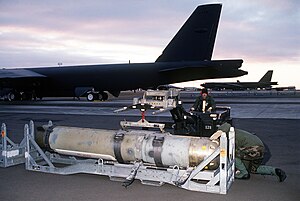| Mark 60 CAPTOR | |
|---|---|
 Mark 60 mine being loaded into a B-52 Stratofortress at Loring Air Force Base in 1989 | |
| Type | Antisubmarine naval mine[1][2][3] |
| Place of origin | United States |
| Service history | |
| In service | 1979-2001[1] |
| Used by | United States Navy |
| Wars | Cold War |
| Production history | |
| Designer | Goodyear Aerospace[3] |
| Manufacturer | Goodyear Aerospace[3] |
| Unit cost | US $113,000 (FY78) US $377,000 (FY86)[3] |
| Produced | 1978-1986[3] |
| Variants | Mine Mk 66, Mk 46 Mod 5 (NEARTIP) |
| Specifications | |
| Mass | Aircraft/ship-laid:1,077 kg (2,374 lb)[1] Submarine-laid:935 kg (2,061 lb)[1] |
| Length | Aircraft/ship-laid:3.68 m (145 in)[1] Submarine-laid:3.35 m (132 in)[1] |
| Diameter | 530 mm (21 in)[1] |
| Effective firing range | 8,000 yards (7,300 m)[2] |
| Warhead | Mark 46 torpedo |
| Warhead weight | 44 kg (97 lb), PBXN-103 |
| Engine | Two-speed, reciprocating external combustion |
| Propellant | Otto fuel II |
| Maximum depth | 1,000 feet (300 m) |
| Maximum speed | >28 knots (52 km/h) |
Guidance system | Active or passive/active acoustic homing, snake or circle search, reliable acoustic path (RAP) sound propagation[2][1][3] |
Launch platform | Aircraft, surface ship and submarines[2][1][3] |
The Mark 60 CAPTOR (Encapsulated Torpedo) is the United States' only deep-water anti-submarine naval mine.[4][3][2] It uses a Mark 46 torpedo[2][3] contained in an aluminum shell that is anchored to the ocean floor.[2] The mine can be placed by either aircraft, submarine or surface vessel.[2][3] The torpedo, once placed, can last anywhere from weeks to months underwater.[3] The original production contract of the CAPTOR mine was awarded to Goodyear Aerospace in 1972, and entered service in 1979.[3] It was hoped to reduce minefield costs and used in the creation of a barrier of the "Greenland-Iceland-United Kingdom gap to interrupt Soviet submarines in the event that deterrence failed."[4]
The mine uses Reliable Acoustic Path (RAP)[2][1] sound propagation to passively identify and track the difference between hostile submarine signatures, surface vessels and friendly submarines.[3] Once identified, the torpedo leaves its casing to destroy its target.
- ^ a b c d e f g h i "Mk 60 Captor Mine | VP-4 Association". www.vp4association.com. 28 May 2011. Retrieved 2017-04-22.
- ^ a b c d e f g h i j k l m "U.S. Naval Mines - Captor program". www.hartshorn.us. Archived from the original on 2012-01-12. Retrieved 2017-04-22.
- ^ a b "Naval Mines and Mining: Innovating in the Face of Benign Neglect". Center for International Maritime Security. 2016-12-20. Retrieved 2017-04-22.